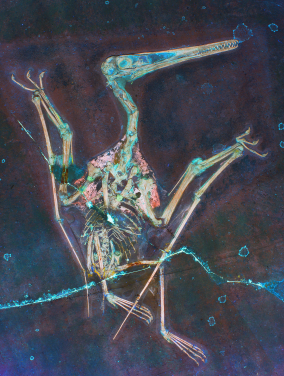Muscular wing-body junction improved Pterosaur flight performance
19 Oct 2021

Figure 1. Laser-stimulated fluorescence imaging of a pterosaur fossil reveals flight-related soft tissues. The imaging revealed a muscular wing root fairing that smooths airflow around the wing-body junction and reduces drag, as in the wing root fairings of modern aeroplanes. (Image credit: Michael Pittman)
The flying reptiles known as pterosaurs are the closest relatives of dinosaurs and were the first vertebrates to evolve powered flight. However, many details of pterosaur flight anatomy and performance are still unclear. According to a new study led by Dr Michael PITTMAN – Research Assistant Professor of the Department of Earth Sciences & Vertebrate Palaeontology Laboratory, The University of Hong Kong (HKU); Assistant Dean (e-learning) of HKU Faculty of Science – pterosaurs evolved a muscular wing-body junction to reduce drag and improve flight performance. The findings were recently published in the Proceedings of the National Academy of Sciences of the United States of America (PNAS).
Dr Pittman and colleagues used laser-stimulated fluorescence to image the bones and reveal soft tissues of a Late Jurassic pterodactyloid pterosaur fossil to analyse its flight performance (Fig. 1). This involved scanning the fossil with a violet laser and taking long-exposure photographs of the fluorescence produced by the pterosaur’s bones and revealed soft tissues. Their results suggest that the pterosaur possessed a wing root fairing, a feature that smooths the airflow around the wing-body junction and reduces drag, as in the wing root fairings of most modern aeroplanes (Fig. 2). “In birds, the wing root fairing is made of feathers. In bats, the wing root fairing is made of fur. In contrast, pterosaurs had a wing root fairing primarily made of skeletal muscle,” notes Mr Luke A. BARLOW, a Research Assistant in Dr Pittman’s lab that studied the specimen.
Dr Pittman said, “This muscular wing root fairing appears to have provided pterosaurs with additional flight benefits, such as improved force generation during the flight stroke and sophisticated control of the wing's shape, including minimising unwanted vibrations or ‘flutter’”. Speaking of the significance of the study, Mr Thomas G KAYE, a study co-author and Director of the Foundation of Scientific Advancement in the United States added, “Our work shows that pterosaurs were more advanced flyers than we thought, even in the Late Jurassic when birds had just evolved flight. Our study also highlights the potential contributions of new technologies to our understanding of pterosaur flight anatomy and evolution. We are excited to see where our work takes us next.”
The paper is published in PNAS and can be accessed here: https://www.pnas.org/content/118/44/e2107631118
The video summary can be viewed here: https://youtu.be/bwhj1pnaFX8
For media enquiries, please contact Ms Casey To, External Relations Officer(tel: 39174948; email: caseyto@hku.hk / Ms Cindy Chan, Assistant Director of Communications of HKU Faculty of Science (tel: 3917 5286; email: cindycst@hku.hk) or Dr Michael Pittman, Research Assistant Professor of the Department of Earth Sciences (email: mpittman@hku.hk).
Images download and captions: https://www.scifac.hku.hk/press
Notes:
1. Most close relatives of birds neared the potential for powered flight but few crossed its thresholds (Aug 2020): https://www.hku.hk/press/press-releases/detail/21405.html
2. HKU imaging technology shows first discovered fossil feather did not belong to iconic bird Archaeopteryx (Feb 2019): https://www.hku.hk/press/press-releases/detail/19063.html
3. Major breakthrough in knowledge of dinosaur appearance HKU palaeontologist reconstructs feathered dinosaurs in the flesh with new technology (March 2017): https://www.hku.hk/press/press-releases/detail/15989.html

